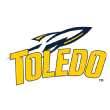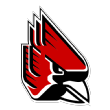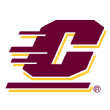The past two years have seen a topsy-turvy existence in college football's MAC West. Only one team enjoyed a winning record in conference play in both 2018 and 2019 (Western Michigan, which didn't win the division either year), while a Central Michigan team that went 0-8 in 2018 won the West 12 months later.
Division stalwarts Northern Illinois and Toledo are coming off of surprisingly shaky campaigns, and the teams at the bottom of the West not too long ago might be at the top this fall. But unlike perhaps any other division in FBS, you can make the case that any of these six teams could end up in the conference title game -- SP+ projects all of them at either 3-5 or 5-3.

Northern Illinois
Head coach: Thomas Hammock (5-7, second year)
2019 record: 5-7 (4-4 in MAC play), 115th in SP+
2020 projection: 4-8 (3-5), 117th in SP+
Top returning players: QB Ross Bowers, DT Jack Heflin, LB Kyle Pugh, WR Cole Tucker, TE Mitchell Brinkman, LB Vinny Labus
With four conference titles, seven division titles and 91 total wins, it's safe to say that NIU was the MAC's program of the decade. The Huskies lost Jerry Kill and Dave Doeren to power conference jobs in the first three years of the 2010s but kept right on winning at a pretty high level with Rod Carey in charge.
Athletic director Sean Frazier had a tricky choice to make, however, when Carey left for Temple following a MAC title run in 2018. Typically when things are going well, it is tempting to hire an assistant already at the school. Carey, after all, was Doeren's offensive coordinator. But the program had slipped a bit.
The Huskies had peaked at 34th in SP+ in 2012 but hadn't ranked higher than 72nd since 2013. Their 2018 title was a bit of a fluke, requiring four consecutive one-score wins in MAC play and a pretty big title-game upset of Buffalo. Their No. 89 SP+ ranking in 2018 was actually their lowest in 11 years.
Perhaps acknowledging this reality, then, Frazier looked outside the 2018 staff, bringing in Thomas Hammock, a former NIU running back and, most recently, the Baltimore Ravens' running backs coach. Hammock hadn't coached in college since 2013 and hadn't coached at the MAC level since 2006. It was fair to assume it might take him a little while to get his footing back in DeKalb, and it was even fairer to assume once you take into account how much his personnel kept shuffling on him.
Quarterback Ross Bowers, a Cal transfer, missed three games, nine different offensive linemen started at least one game, and a trio of star linebackers -- Kyle Pugh, Antonio Jones-Davis, and Lance Deveaux Jr. -- combined to play in just nine games.
Projected 73rd in SP+, the Huskies had fallen into the 110s by the end of September and remained there. Three tight wins in conference play kept the win total respectable, but on paper this was the worst NIU team since the 2-10 squad of 2007 or the 2-9 team of 1998. This was most certainly a Year Zero situation for Hammock, and it was impossible to separate his own potential growing pains and faults from what his two-deep pretty clearly lacked. But he signed a pretty good recruiting class, and while depth could be a clear issue on the lines, it appears he'll have a bit more to work with this year, at least as long as the injury bug doesn't bite too hard again.
I loved Hammock's hire of former South Dakota State offensive coordinator Eric Eidsness, but while NIU did improve by 11 spots in offensive SP+ last year, that was clearing a low bar -- they still ranked 106th. Eidsness appeared to strive for balance but found little efficiency via either run or pass. Bowers will still have an interesting skill corps around him, one that features receiver Cole Tucker (531 receiving yards, 8.9 per target), slot man Tyrice Richie (415, 7.7), and tight end Mitchell Brinkman (445, 9.1) but won't feature 1,000-yard running back Tre Harbison, who transferred to Charlotte.
NIU ranked in the defensive SP+ top 30 in both 2017 and 2018, but thanks to both the loss of star end Sutton Smith and in-season injuries, it was a shell of its former self, falling to 103rd. With Pugh and tackle Jack Heflin back, the Huskies should be solid in the middle, but the edge talent is unproven at best, the starting safeties are gone, and while plenty of CBs got reps because of injuries last year, none of them stood out except maybe sophomore Antwain Walker, who missed all but three games. It's hard to be too optimistic here.
This is a tricky spot for Hammock. NIU wasn't as good as its mediocre record last year, and while that might not have been his fault, fans will likely get restless after what's shaping up to be another rebuilding year. You don't want to follow up your best decade ever by sinking to the bottom of the MAC West.

Eastern Michigan
Head coach: Chris Creighton (28-47, seventh year)
2019 record: 6-7 (3-5 in MAC play), 101st in SP+
2020 projection: 4-8 (3-5), 116th in SP+
Top returning players: DE Turan Rush, WR Quian Williams, CB Freddie McGee III, LB Terry Myrick, WR Dylan Drummond
It is incredible to think about what Chris Creighton has accomplished at EMU.
When Creighton arrived in Ypsilanti in 2014, the Eagles hadn't enjoyed a winning season in 19 years and hadn't been to a bowl in 27. In fact, since joining what would become the FBS in 1975, they had managed only three winning records, compared to a downright cruel 15 seasons with two or fewer wins. They had yet to beat a power conference team. There are plenty of nearly hopeless jobs in FBS; this might have been the most hopeless of all.
That hopelessness might be why Creighton got a shot in the first place. He boasted 16 years of head-coaching experience and eight conference titles, but they came at the NAIA (Ottawa), Division III (Wabash), and non-scholarship FCS levels (Drake). Jim Harbaugh aside, a successful Pioneer League coach doesn't usually get a shot at an FBS job, but EMU needed someone to take the job. And after winning just three games in his first two seasons, here's what his Eagles have done since:
In 2016, they beat Bowling Green, Ohio and Ball State on the road on the way to a 7-6 finish and their first bowl in nearly three decades.
In 2017, they beat Rutgers, scoring their first win over a Power 5 program. In 2018 (Purdue) and 2019 (Illinois), they earned their second and third, bowling again in both years as well.
Granted, Creighton has yet to win a bowl or division title, but that's almost a good thing -- it's kept him off of bigger programs' radars. He's back at EMU for a seventh season.
Before Creighton arrived, a 4-8 season would have been considered a pretty solid campaign, and that makes 2020 a pretty interesting year for EMU. After years of solid continuity, the Eagles have to replace their starting quarterback, two of their top three RBs, three of five WRs, and about half of their starting defense, including a pair of dynamite safeties (Vince Calhoun and Brody Hoying) and leading tackler Kobie Beltram. With a schedule that features trips to Kentucky, Missouri and Army, not to mention Ball State, Miami (Ohio), Ohio and WMU, reaching a bowl for a fourth time seems dicey. In fact, SP+ projects a stumble to, yes, 4-8. There was no predicting that Creighton would be capable of building what he has built in Ypsilanti, but can he avoid a temporary stumble this fall?
A large portion of that answer will depend on the quarterback position. Mike Glass III is gone his final snap was one of the most memorable you'll ever see), and his successor will have survived a battle royale to win the job, though you figure junior (and 2019 backup) Preston Hutchinson and Southern Utah grad transfer Chris Helbig have the best odds.
The running back corps is in flux, but the new QB will have a seasoned line (four regulars return) and an intriguingly efficient receiving corps led by juniors Quian Williams and Dylan Drummond. The known big-play threats are scarce, though juco transfer C.J. Parks could change that.
The EMU offense had to carry extra weight in 2019 because the defense collapsed, falling from 52nd to 118th in defensive SP+. The run defense was ghastly, and the only real disruption came from the safeties, Calhoun and Hoying (combined: 10 tackles for loss, 11 passes defensed, five forced fumbles). Juco transfer Noski Lafleur was intriguing as Hoying's understudy, and senior corner Freddie McGee III isn't bad. But these two pretty much have to dominate this year -- the Eagles only have one known pass-rusher (the aptly named Turan Rush), and while the defensive tackle unit is vastly more experienced this year, we don't know much about its quality. EMU will get a field position boost from a sturdy, experienced special-teams unit, but the defense needs to be a bit more rigid than it was last year.
EMU won't have a shot at a fourth straight Big Ten win this fall, but maybe that's a good thing, too. As thrilling as those wins have been, the Eagles fell into a serious funk after each win: they lost six games in a row in 2017 and four straight in 2018, and after the thriller at Illinois last year, they needed a last-second blocked punt to beat Central Connecticut, then lost four of five. Maybe they'll save their best work for MAC play this time around.

Western Michigan
Head coach: Tim Lester (20-18, fourth year)
2019 record: 7-6 (5-3 in MAC play), 90th in SP+
2020 projection: 6-6 (5-3), 97th in SP+
Top returning players: LB Treshaun Hayward, WR Skyy Moore, NT Ralph Holley, LT Jaylon Moore, CB Patrick Lupro
It is the way of life for most Group of 5 or lower programs: You hire a coach, probably a young, energetic up-and-comer, and you hope that he wins big -- a conference title, maybe, or at least double-digit wins. If that all goes well, your reward is losing your coach to a bigger school and looking for another young, energetic up-and-comer to replace him.
Chances are, unless you're Boise State, you'll regress toward your historic mean. (Even BSU has regressed from its early-2010s peak.) It's really hard to make two great hires in a row, much less three or more. At some point, probably soon, there will be a misstep.
Case in point: Western Michigan. In 2013, the Broncos hired the youngest, most energetic up-and-comer imaginable, 32-year-old former NIU receiver PJ Fleck, to succeed Bill Cubit, a more seasoned veteran who had a few good seasons but couldn't build anything sustainable. Fleck tacked "Row the Boat" stickers on every inch of the football facility, signed some of the best recruiting classes in the history of the MAC, endured some early growing pains, and ignited. After losing 14 of his first 17 games in charge, Fleck and his Broncos won 12 of their next 19, then ripped off a 15-game winning streak, won the 2016 MAC title, and reached the Cotton Bowl, where they lost a competitive 24-16 game against Wisconsin.
This was the most successful hire WMU has ever made. And as a reward, the Broncos had to start anew in 2017 after losing Fleck to Minnesota.
Instead of promoting one of Fleck's coordinators, WMU brought in Tim Lester, a former WMU star quarterback and, most recently, Purdue's QBs coach. The program has quickly, and predictably, regressed toward its historic mean.
That doesn't mean Lester has done a bad job. In three years, he has yet to finish under .500, either overall or in conference play. Fleck's recruits have just about cycled out, but Lester has continued to recruit at an upper-half-of-the-MAC level, and the last two years he's fielded top-60 offenses, per SP+. His performance has only disappointed compared to Fleck's.
In the search for his own breakthrough, Lester's biggest issue moving forward might be one of class balance. This year's two-deep will feature both key senior contributors and a batch of intriguing sophomores. The offensive line could start five seniors, and the core of the defense is made up of end Ali Fayad, tackle Ralph Holley, middle linebacker Treshaun Hayward, and safety A.J. Thomas, all seniors. Senior D'Wayne Eskridge could be the best cornerback and/or wideout on the roster, too, depending on how he's deployed. Pitt grad transfer (and senior) Therran Coleman could play a role in the secondary as well.
If key sophomores are ready, this could be a big year. Quarterback Kaleb Eleby completed 63% of his passes during a 2018 audition, running back Sean Tyler averaged 5.7 yards per carry last year, and receivers Skyy Moore and DaShon Bussell caught a combined 78 passes for 1,247 yards as freshmen. On defense, linemen Will McCabe, Braden Fiske and Andre Carter, linebacker Corvin Moment, and corner Keni-H Lovely could all play key roles. Will they be ready? Do they need a year of growing into larger roles, after which WMU will be rebuilding on the O-line and in the secondary?
The volatility of youth is compounded by what was a pretty all-or-nothing offense to begin with. WMU was a solid 45th in offensive success rate but eighth in marginal explosiveness. A reliance on big plays means some all-or-nothing spells, and WMU scored 17 or fewer points three times and 48 or more three times. Eleby and redshirt freshman receiver Cameron Coleman were pretty top-notch recruits in the St. Louis area, and their addition to the lineup, alongside Nevada transfer Jaxson Kincaide, Michigan State transfer La'Darius Jefferson (if eligible) and the aforementioned Tyler, Moore and Bussell -- and maybe Eskridge! -- gives the Broncos even more upside and potentially more unpredictability.
This uncertainty makes WMU a difficult team to project. This team has as much upside as any in the division, but it's hard to confidently say all the arrows will be pointed in the right direction at the right time. But in a crowded MAC West, the Broncos might have as much of a chance as anyone to make noise. They do have to play on the road against two of the three teams above them in the SP+ projections, though.

Toledo
Head coach: Jason Candle (34-19, fifth year)
2019 record: 6-6 (3-5), 114th in SP+
2020 projection: 7-5 (5-3), 93rd in SP+
Top returning players: WR Bryce Mitchell, NB Saeed Holt, RB Bryant Koback, LG Nick Rosi, CB Sam Womack
You're in charge of one of the most consistently solid programs in the Group of 5, and you're looking for some solutions. After flirting with lofty heights for a while, you finally broke through with 11 wins and a conference title in 2017, but your defense collapsed the following year, and your offense followed suit last fall. Only five close wins against a particularly weak schedule kept you bowl eligible. Returns have diminished, and you have to figure fan patience might soon wear thin. What do you do?
If you're Jason Candle, you bring in some ringers.
Toledo ranked 114th in SP+ last year; its rating was in the 14th percentile of FBS, the program's worst performance since 1978, before Candle was even born. To his credit, he didn't take this failure lightly, even though the Rockets indeed still managed to go 6-6. He dismissed defensive coordinator Brian George and linebackers coach Mike Ward, who had been with him during his entire stint at UT. He also aimed high in looking for replacements, bringing in Craig Kuligowski, one of the most renowned and TFLs-friendly defensive line coaches on the planet, and Vince Kehres, winner of 95 games (and loser of only six) in seven seasons of succeeding his father Larry as head coach at Division III power Mount Union.
Candle also hired Robert Weiner, a four-time state championship head coach at Tampa's Plant High School, as his offensive co-coordinator. And then he inked a 2020 class that ranked 74th overall per RecruitingNation, first in the MAC.
That's a pretty good January right there. Now it has to translate into the fall.
It took more than staleness on the coaching staff for Toledo to struggle as much as it did last fall: it also required some QB issues. Mitchell Guadagni completed 65% of his passes with a 159 passer rating, but after dealing with a concussion early in the season, he missed the last half of the year with a shoulder injury.
Eli Peters and Carter Bradley both struggled in Guadagni's absence, but Peters found a nice rhythm in wins over EMU and Kent State and a narrow loss to NIU. Then he got hurt, too. In the end, all three QBs threw between 105 and 122 passes, and redshirting freshman DeQuan Finn made a late cameo as well. Guadagni is gone, but the other three are back, along with incoming star recruit Gavin Hall. You figure Peters is the favorite to start, but there could be strong competition.
The QB of choice will have experience all around him. Running back Bryant Koback (1,187 yards, 6.1 per carry), receivers Danzel McKinley-Lewis and Bryce Mitchell (combined: 1,294 yards, 9.8 per target), and six linemen with a combined 70 career starts all return, including center Bryce Harris, who missed last year with a knee injury. After averaging an offensive SP+ ranking of 34th from 2011 to '18, the Rockets should rebound after slipping to 83rd.
The defense's slippage -- from top-60 in defensive SP+ from 2015-17, to 102nd in 2018, to 121st in 2019 -- is more of a long-term issue and might be harder to correct unless both Kuligowski and Kehres are dominant out of the gates.
Kuligowski oversaw a run of dominant DEs at Missouri before moving on to Miami and Alabama, and it's safe to say he'll coax quite a bit of production out of a foursome of junior ends: Jamal Hines, Nate Givhan, Desjuan Johnson and Terrance Taylor. But at what cost? The Rockets tried to create as much havoc and disruption as possible in 2019, but while the ends were decent against the run, nickelback Saeed Holt (11 TFLs, 3.5 sacks) was strong, and the cornerbacks got hands on lots of passes, opposing offenses parried most of the attacks, and Toledo allowed 6.8 gains per game of 20-plus yards, worst in FBS. There's disruptive, and then there's reckless. We'll see if Kehres, as first-year coordinator, balances those things a bit better.
Toledo's long-term success, along with always-strong recruiting, makes it a bounce-back candidate in SP+'s eyes. But a little bit of added improvement could go a long way: UT's schedule features three likely wins (Central Connecticut, BGSU and Akron), one likely loss (at Michigan State), and a whopping eight games projected within one touchdown. That's about as many projected close games as you're ever going to see.

Ball State
Head coach: Mike Neu (15-33, fifth year)
2019 record: 5-7 (4-4), 86th in SP+
2020 projection: 7-5 (5-3), 84th in SP+
Top returning players: CB Amechi Uzodinma II, RG Curtis Blackwell, LB Jaylin Thomas, QB Drew Plitt, RB Caleb Huntley
Say this for Mike Neu: He's a grinder. Things have been the opposite of smooth for him in four years in Muncie, but he's continuing to search for, and come awfully close to, a breakthrough.
In 2016, his debut season, the former Ball State quarterback and New Orleans Saints QBs coach engineered immediate on-field improvement. The Cardinals' once-potent offense had faded in the final days of the Pete Lembo era, but it rebounded to 73rd in offensive SP+. BSU was 96th overall, but while that's usually good enough to earn you a bowl bid in the MAC, a 1-4 record in one-score games rendered it 4-8.
In 2017, the depth chart imploded. Star quarterback Riley Neal got hurt three games in, and no other QB was close to ready. No one on the entire offense could stay healthy, the defense still wasn't good, and BSU was legitimately the worst team in the country over the second half of the season, finishing 123rd in SP+ and 2-10.
Neu's 2018 team was more experienced and healthier, but only marginally so. This time the defense got waylaid by injury. BSU "improved" to 119th and 4-8, but you had to figure Neu had used up all of his mulligans, and he faced having to improve without either Neal or running back James Gilbert, both of whom left for power conference teams as grad transfers.
BSU indeed improved last year. The new offense surged to 60th in offensive SP+. Quarterback Drew Plitt threw for nearly 3,000 yards, two backs (Caleb Huntley and Edinboro transfer Walter Fletcher) rushed for 2,001 yards, and five receivers produced between 300 and 700 yards. The line dealt with a new round of shuffling (only two guys started every game) but held up.
The defense produced its best numbers in six years as well, rising to 92nd. Despite a tiny rotation on the line, defensive coordinator David Elson figured out ways to get more disruptive against the run while preventing big plays in the back. The defense faded after a midseason surge, and Elson was let go, but this BSU team clearly had far more to offer.
It also managed to lose three November games by a combined eight points and once again miss out on a bowl. Ball State had the fourth-best SP+ rating in the MAC but finished 5-7. (Neu is now 5-11 in one-score games.)
So is this the year then? The offense is still scheduled to return Plitt, Huntley, leading receiver Justin Hall, big-play threat Yo'Heinz Tyler, and six linemen with starting experience. And while the defensive line is almost entirely unproven -- only four guys logged 200-plus snaps, and three are gone -- the back eight packs massive experience and disruption potential.
A lot of that potential comes from the linebacker position, where veterans Jaylin Thomas, Christian Albright, and Jordan Williams combined for 30% of BSU havoc plays (TFLs, passes defensed, forced fumbles) last fall. It would make sense, then, that Neu promoted inside linebackers coach Tyler Stockton to defensive coordinator.
Stockton is a rising star. He was a member of the 2012 Notre Dame team that made the BCS championship game, and he was an FCS defensive coordinator, at Western Illinois, just six years later. If he can figure out how to patch together a sturdy line from random pieces -- end James Jennette III, Sacred Heart transfer Chris Agyemang, sophomore tackle Emeka Jiliani, juco transfer Joshua Tarango, etc. -- he's got the rest of what he needs. That means not only the linebackers but also star cornerbacks Amechi Uzodinma II and Antonio Phillips, safety Bryce Cosby, and Norfolk State-via-WIU transfer J.T. Wahee.
(I've enjoyed that Neu has been liberal in looking for small school stars to call up. It worked well with Fletcher last year, and the addition of Agyemang and Wahee could have a similar effect on his defense in 2020. The transfer portal doesn't only have to work for the P5 schools.)
After nonconference road trips to Michigan and Indiana, it'll be up to Neu, Plitt, etc., to figure out how BSU can actually win enough close games to finally reach a bowl. In theory, BSU has more than enough pieces to do it, but that was the case last year, too.
Ball State has continued to show faith that the injuries and close losses that have held Neu back will eventually turn around. Now seems like a pretty good time to prove that theory correct.

Central Michigan
Head coach: Jim McElwain (8-6, second year)
2019 record: 8-6 (6-2), 85th in SP+
2020 projection: 7-5 (5-3), 82nd in SP+
Top returning players: WR JaCorey Sullivan, LB Troy Brown, LG Derek Smith, DT Robi Stuart, DE LaQuan Johnson
Central Michigan and Jim McElwain needed each other. The Chippewas and their new head coach both found themselves directionless a year ago, the former having plummeted to 1-11, with maybe the worst offense in school history, in 2018, and the latter having been fired from Florida after a short tenure with the Gators came to a strange end. After a year as Michigan's receivers coach, McElwain seized an opportunity up the road in Mount Pleasant. The arrangement worked wonders for both entities.
Despite a pretty massive rebuild -- CMU ranked 130th, dead last, in offensive SP+ in 2018 and had to replace most of the starting lineup of a pretty good defense -- McElwain and his staff only needed a few weeks to figure some things out. The Chips took a resounding 61-0 beating from Wisconsin in Week 2 and found themselves 2-3 and 120th in SP+ at the end of September, but they rallied, winning six of seven games to rise to 70th and scoring an out-of-nowhere division title.
This midyear turnaround happened despite starting quarterback David Moore getting suspended after testing positive for a banned substance and the secondary seemingly never quite staying at full strength. Unfortunately, the Chips took their foot off of the gas after the late surge. They were upset by an inferior-on-paper Miami (Ohio) in the MAC title game, then got smoked by San Diego State 48-11 in the New Mexico Bowl.
This was an awfully impressive coaching performance from McElwain, serving as a reminder that he was regarded as quite the up-and-comer (or as much of an up-and-comer you can be in your mid-50s) not too long ago. He was linked with a few P5 jobs during the past coaching carousel, but for now, at least, he remains at CMU. So do offensive coordinator Charlie Frye and defensive coordinator Robb Akey.
Moore's suspension was almost a blessing in disguise. It gave grad transfer Quinten Dormady a shot -- another shot, actually, as he began the year as the starter but hurt his knee -- and he took advantage. Including sacks, he averaged 7.2 yards per pass attempt to Moore's 6.3. His last three games of the regular season were absurd: 60-for-81 passing for 894 yards, five touchdowns, one interception, and a 184.7 passer rating. (His postseason was miserable, but we're being positive here.)
Dormady is gone, however, and barring appeal, Moore could still be suspended for another month when the season begins. That means the Chips could go through non-conference play with an entirely untested quarterback like sophomore George Pearson, redshirt freshman Daniel Richardson, or incoming freshman Tyler Pape.
This skill corps could carry a lot of weight for a young QB, though. Running back Kobe Lewis was all-or-nothing last year -- but he had quite a few "alls," averaging 5.9 yards per carry. And the receiving corps features high-usage slot man Kalil Pimpleton, big-play wideouts JaCorey Sullivan and Tyrone Scott, and star tight end Tony Poljan, a former QB. The line does have to replace three starters, but the returnees (guard Derek Smith and tackle Luke Goedeke) were both all-conference performers last year, per Pro Football Focus.
The defense should be one of the MAC's best. CMU ranked 72nd in defensive SP+ and shined in aggressiveness categories: ninth in FBS in havoc rate, first in stuff rate. In open-play situations (snaps between the offense's 10 and the opponent's 30), CMU was devastating in both creating third-and-longs (fifth in average third-down distance) and feasting on them (ninth in third-down success rate).
Most of the reasons for this success are scheduled to return, including end LaQuan Johnson and tackle Robi Stuart (combined: 22.5 tackles for loss, nine sacks, 30 run stuffs) and linebackers Troy Brown and Chuck Jones (23 TFLs, 28 stuffs). The secondary takes a hit with the loss of safety Da'Quaun Jamison and the likely loss of corner Kyron McKinnie-Harper (he's in a bit of trouble at the moment) but should return everybody else. It also adds Florida transfer Brian Edwards and corner Dishon McNary, a juco transfer who redshirted but looked solid in the bowl loss.
Typically, when a team surges like CMU did over the second half of 2019, the primary hope for the next season should be to sustain your gains and let your foundation settle -- another huge rise is rare. CMU is projected to slip a hair to 82nd in SP+, but they'll have as good a chance as anyone to win what should be a tight MAC West race.
